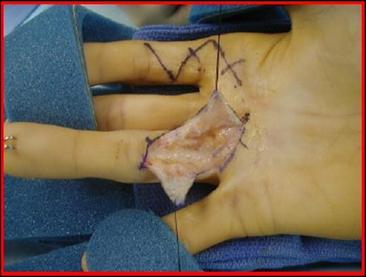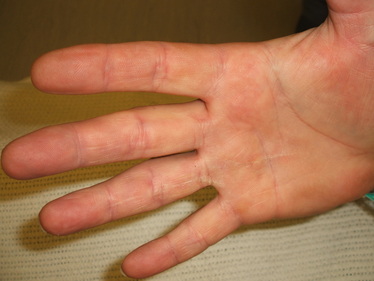 Intraoperative photo
Intraoperative photo
What does Limited fasciectomy mean?
Fasciectomy (fasci- = fascia ; -ectomy = excise) literally means to take out the fascia, which is the fibrous layer beneath the skin. Long ago surgeons used to remove the entire fascia (both the disease and undiseased fascia) from beneath the palmar skin, called extensive fasciectomy, with the thought that this would cure the patient of Dupuytren's disease. It didn't! Not only did the disease still recur, but the complications (in particular slow healing from skin loss) were unacceptable, and so it is no longer performed. Limited fasciectomy involves removing only the diseased fascia, the Dupuytren's cords and nodules, and leaving the uninvolved tissues,
How is Limited fasciectomy performed?
Under either an arm block (numb arm) or general anaesthetic, and using an arm tourniquet, the skin is raised (usually through zig-zag flaps as shown), and the Dupuytrens disease excised. This surgery is performed under magnification in order to protect the fine nerves and arteries to the fingers. The skin flaps are then stitched back at the end, and a dressing applied.
Fasciectomy (fasci- = fascia ; -ectomy = excise) literally means to take out the fascia, which is the fibrous layer beneath the skin. Long ago surgeons used to remove the entire fascia (both the disease and undiseased fascia) from beneath the palmar skin, called extensive fasciectomy, with the thought that this would cure the patient of Dupuytren's disease. It didn't! Not only did the disease still recur, but the complications (in particular slow healing from skin loss) were unacceptable, and so it is no longer performed. Limited fasciectomy involves removing only the diseased fascia, the Dupuytren's cords and nodules, and leaving the uninvolved tissues,
How is Limited fasciectomy performed?
Under either an arm block (numb arm) or general anaesthetic, and using an arm tourniquet, the skin is raised (usually through zig-zag flaps as shown), and the Dupuytrens disease excised. This surgery is performed under magnification in order to protect the fine nerves and arteries to the fingers. The skin flaps are then stitched back at the end, and a dressing applied.

Is Limited fasciectomy correct for me?
Results from Limited fasciectomy are usually longer lasting than after needle aponeurotomy or Xiapex. However you need to take more time off work or day-to-day life, as the operated hand will be out of action for normally between 2 to 6 weeks. You will probably need more help at home. Sutures are removed at 2 weeks, but it takes longer for the hand to fully heal and get moving again. You will also need to attend for hand therapy.
What are the specific risks of Limited fasciectomy?
Over and above the usual risks of hand surgery (see under Dupuytren's) the following can happen with Limited fascietomy:
- skin flap necrosis (usually just the tips of the skin flaps die back a bit, which would then be left to heal in by themselves, but does prolong the healing)
- reduced sensation (if a nerve is damaged it would be repaired, but full return of sensation would not occur)
- reduced or even no blood flow into fingers: scarring may surround the arteries and could reduce blood flow, normally noticed as a reduced tolerance of that finger to the cold. It is possible to have no blood flow back into a finger, though thankfully this has never happened to me!
Results from Limited fasciectomy are usually longer lasting than after needle aponeurotomy or Xiapex. However you need to take more time off work or day-to-day life, as the operated hand will be out of action for normally between 2 to 6 weeks. You will probably need more help at home. Sutures are removed at 2 weeks, but it takes longer for the hand to fully heal and get moving again. You will also need to attend for hand therapy.
What are the specific risks of Limited fasciectomy?
Over and above the usual risks of hand surgery (see under Dupuytren's) the following can happen with Limited fascietomy:
- skin flap necrosis (usually just the tips of the skin flaps die back a bit, which would then be left to heal in by themselves, but does prolong the healing)
- reduced sensation (if a nerve is damaged it would be repaired, but full return of sensation would not occur)
- reduced or even no blood flow into fingers: scarring may surround the arteries and could reduce blood flow, normally noticed as a reduced tolerance of that finger to the cold. It is possible to have no blood flow back into a finger, though thankfully this has never happened to me!